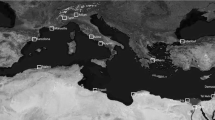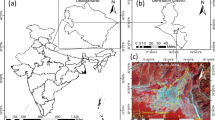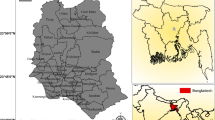Abstract
With the rapid development of urban agglomerations in northwest arid and semiarid regions of China, the scope of the urban heat island (UHI) effect has gradually expanded and gradually connected, and has formed a regional heat island (RHI) with a larger range of impact to the regional environment. However, there are few studies on the heat island effect of urban agglomerations in arid and semiarid regions, so this paper selects the urban agglomeration of Hohhot, Baotou and Ordos (HBO) of Inner Mongolia, China as the study area. Based on the 8-day composite Moderate-resolution Imaging Spectroradiometer (MODIS) surface temperature data (156 scenes in all) and land use maps for 2005, 2010, and 2015, we analyze the spatiotemporal distributions of regional heat (cool) islands (RH(C)I) and the responses of surface temperatures to land-use changes in the diurnal and interannual surface cities. The results showed that: 1) from 2005 to 2015, urban areas showed the cold island effect during the day, with the area of the cold island showing a shrinking feature; at night, they showed the heat island effect, with the area of the heat island showing a first decrease and then an increase. 2) From 2005 to 2015, the land development (unutilized land to building land) brings the greatest temperature increase (ΔT = 1.36°C) during the day, while the greatest temperature change at night corresponds to the conversion of cultivated land to building land (ΔT = 0.78°C) exhibited the largest changes at night. From 2010 to 2015, the land development (grassland to building land) bring the greatest temperature increase (ΔT = 0.85°C) during the day, while the great temperature change at night corresponds to the conversion of water areas to building land (ΔT = 1.38°C) exhibited the largest changes at night. Exploring the spatial and temporal evolution of surface urban heat (cool) islands in urban agglomerations in arid and semiarid regions will help to understand the urbanization characteristics of urban agglomerations and provide a reference for the formulation of policies for the coordinated and healthy development of the region and co-governance of regional environmental problems.
Similar content being viewed by others
References
Akbari H, Kolokotsa D, 2016. Three decades of urban heat islands and mitigation technologies research. Energy and Buildings, 133: 834–842. doi: https://doi.org/10.1016/j.enbuild.2016.09.067
Alahmad B, Tomasso L P, Al-Hemoud A et al., 2020. Spatial distribution of land surface temperatures in kuwait: urban heat and cool islands. International Journal of Environmental Research and Public Health, 17(9): 2993. doi: https://doi.org/10.3390/ijerph17092993
Bindajam A A, Mallick J, Alqadhi S et al., 2020. Impacts of vegetation and topography on land surface temperature variability over the semi-arid mountain cities of saudi arabia. Atmosphere, 11(7): 762. doi: https://doi.org/10.3390/atmos11070762
Bonafoni S, Baldinelli G, Verducci, 2017. Sustainable strategies for smart cities: analysis of the town development effect on surface urban heat island through remote sensing methodologies. Sustainable Cities and Society, 29: 211–218. doi: https://doi.org/10.1016/j.scs.2016.11.005
Debbage N, Shepherd J M, 2015. The urban heat island effect and city contiguity. Computers, Environment and Urban Systems, 54: 181–194. doi: https://doi.org/10.1016/j.compenvurbsys.2015.08.002
Du H Y, Wang D D, Wang Y Y et al., 2016. Influences of land cover types, meteorological conditions, anthropogenic heat and urban area on surface urban heat island in the yangtze river delta urban agglomeration. Science of the Total Environment, 571: 461–470. doi: https://doi.org/10.1016/j.scitotenv.2016.07.012
Duan S B, Li Z L, Leng P, 2017. A framework for the retrieval of all-weather land surface temperature at a high spatial resolution from polar-orbiting thermal infrared and passive microwave data. Remote Sensing of Environment, 195: 107–117. doi: https://doi.org/10.1016/j.rse.2017.04.008
Fang Chuanglin, Zhou Chenghu, Gu Chaolin et al., 2016. Theoretical analysis of interactive coupled effects between urbanization and eco-environment in mega-urban agglomerations. Acta Geographica Sinica, 71(4): 531–550. (in Chinese)
Fu P, Weng Q H, 2016. A time series analysis of urbanization induced land use and land cover change and its impact on land surface temperature with Landsat imagery. Remote Sensing of Environment, 175: 205–214. doi: https://doi.org/10.1016/j.rse.2015.12.040
Gao J, Yu Z W, Wang L C et al., 2019. Suitability of regional development based on ecosystem service benefits and losses: a case study of the Yangtze River Delta urban agglomeration, China. Ecological Indicators, 107: 105579. doi: https://doi.org/10.1016/j.eco-lind.2019.105579
Ge Weiqiang, Zhou Hongmei, Yang Hequn, 2010. Characteristics analysis on heat island effect in Yangtze Delta urban agglomerations in recent 8 years by MODIS data. Meteorological Monthly, 26(11): 77–81. (in Chinese)
Haashemi S, Weng Q H, Darvishi A et al., 2016. Seasonal variations of the surface urban heat island in a semi-arid city. Remote Sensing, 8(4): 352. doi: https://doi.org/10.3390/rs8040352
Han G F, Xu J H, 2013. Land surface phenology and land surface temperature changes along an urban-rural gradient in Yangtze River Delta, China. Environmental Management, 52(1): 234–249. doi: https://doi.org/10.1007/s00267-013-0097-6
Inner Mongolia Autonomous Region Statistics Bureau, 2016. Inner Mongolia Statistical Yearbook 2015.
Jahangir M S, Moghim S, 2019. Assessment of the urban heat island in the city of tehran using reliability methods. Atmospheric Research, 225: 144–156. doi: https://doi.org/10.1016/j.atmosres.2019.03.038
Lazzarini M, Marpu P R, Ghedira H, 2013. Temperature-land cover interactions: the inversion of urban heat island phenomenon in desert city areas. Remote Sensing of Environment, 130: 136–152. doi: https://doi.org/10.1016/j.rse.2012.11.007
Lemoine-Rodríguez R, Inostroza L, Zepp H, 2022. Intraurban heterogeneity of space-time land surface temperature trends in six climate-diverse cities. Science of the Total Environment, 804: 150037. doi: https://doi.org/10.1016/j.scitotenv.2021.150037
Li W F, Han C M, Li W J et al., 2020. Multi-scale effects of urban agglomeration on thermal environment: a case of the Yangtze River Delta Megaregion, China. Science of the Total Environment, 713: 136556. doi: https://doi.org/10.1016/j.scitotenv.2020.136556
Liao D Q, Zhu H N, Jiang P, 2021. Study of urban heat island index methods for urban agglomerations (hilly terrain) in Chongqing. Theoretical and Applied Climatology, 143(1): 279–289. doi: https://doi.org/10.1007/s00704-020-03433-8
Lin Zhongli, Xu Hanqiu, Chen Hong, 2018. Urban heat island change and its relationship to the urbanization of three major urban agglomerations in China’s eastern coastal region. Research of Environmental Sciences, 31(10): 1695–1704. (in Chinese)
Luintel N, Ma Weiqiang, Ma Yaoming et al., 2019. Spatial and temporal variation of daytime and nighttime MODIS land surface temperature across Nepal. Atmospheric and Oceanic Science Letters, 12(5): 305–312. doi: https://doi.org/10.1080/167424834.2019.1625701
Majumder A, Setia R, Kingra P K et al., 2021. Estimation of land surface temperature using different retrieval methods for studying the spatiotemporal variations of surface urban heat and cold islands in indian punjab. Environment, Development and Sustainability, 23(11): 15921–15942. doi: https://doi.org/10.1007/s10668-021-01321-3
Mathew A, Khandelwal S, Kaul N, 2018. Analysis of diurnal surface temperature variations for the assessment of surface urban heat island effect over Indian cities. Energy and Buildings, 159: 271–295. doi: https://doi.org/10.1016/j.enbuild.2017.10.062
Mohammad P, Goswami A, Bonafoni S, 2019. The impact of the land cover dynamics on surface urban heat island variations in semi-arid cities: a case study in Ahmedabad City, India, using multi-sensor/source data. Sensors, 19(17): 3701. doi: https://doi.org/10.3390/s19173701
Naserikia M, Asadi Shamsabadi E, Rafieian M et al., 2019. The urban heat island in an urban context: a case study of Mashhad, Iran. International Journal of Environmental Research and Public Health, 16(3): 313. doi: https://doi.org/10.3390/ijerph16030313
Oleson K W, Monaghan A, Wilhelmi O et al., 2015. Interactions between urbanization, heat stress, and climate change. Climatic Change, 129(3–4): 525–541. doi: https://doi.org/10.1007/s10584-013-0936-8
Peng J, **e P, Liu Y X et al., 2016. Urban thermal environment dynamics and associated landscape pattern factors: a case study in the Bei**g metropolitan region. Remote Sensing of Environment, 173: 145–155. doi: https://doi.org/10.1016/j.rse.2015.11.027
Peng S S, Piao S L, Ciais P et al., 2012. Surface urban heat island across 419 global big cities. Environmental Science & Technology, 46(2): 696–703. doi: https://doi.org/10.1021/es2030438
Qiao Zhi, Tian Guang**, 2015. Dynamic monitoring of the footprint and capacity for urban heat island in Bei**g between 2001 and 2012 based on MODIS. Journal of Remote Sensing, 19(2): 476–484. (in Chinese)
Qin Menglin, Song Wenbo, Song Yuanzhen et al., 2020. Study on spatial features and evolutionary trend of heat islands in Beibu Gulf urban agglomeration. Journal of Safety and Environment, 20(4): 1557–1566. (in Chinese)
Quintana-Talvac C, Corvacho-Ganahin O, Smith P et al., 2021. Urban heat islands and vulnerable populations in a mid-size coastal city in an arid environment. Atmosphere, 12(7): 917. doi: https://doi.org/10.3390/atmos12070917
Rasul A, Balzter H, Smith C et al., 2017. A review on remote sensing of urban heat and cool islands. Land, 6(2): 38. doi: https://doi.org/10.3390/land6020038
Seto K C, Güneralp B, Hutyra L R, 2012. Global forecasts of urban expansion to 2030 and direct impacts on biodiversity and carbon pools. Proceedings of the National Academy of Sciences of the United States of America, 109(40): 16083–16088. doi: https://doi.org/10.1073/pnas.1211658109
Song Yongyong, Xue Dongqian, Ma Beibei et al., 2020. Urbanization process and its ecological environment response pattern on the Loess Plateau, China. Economic Geography, 40(6): 174–184. (in Chinese)
Stewart I D, 2011. A systematic review and scientific critique of methodology in modern urban heat island literature. International Journal of Climatology, 31(2): 200–217. doi: https://doi.org/10.1002/joc.2141
Sun Y, Hu T, Zhang X B et al., 2019. Contribution of global warming and urbanization to changes in temperature extremes in eastern China. Geophysical Research Letters, 46(20): 11426–11434. doi: https://doi.org/10.1029/2019gl084281
Sun Zongyao, Sun **hua, Xu **nliang et al., 2018. Study on the contribution of land use heterogeneity and change to regional thermal environment: a case study of Bei**g-Tian**-Hebei urban agglomeration. Ecology and Environmental Sciences, 27(7): 1313–1322. (in Chinese)
Taha H, 1997. Urban climates and heat islands: albedo, evapotranspiration, and anthropogenic heat. Energy and Buildings, 25(2): 99–103. doi: https://doi.org/10.1016/S0378-7788(96)00999-1
UN-Habitat, 2016. Urbanization and Development: Emerging Futures. Nairobi: UN-Habitat.
United Nations, Department of Economiical and Social Affairs, 2018. World Urbanization Prospects: The 2018 Revision, Highlights. New York: United Nations.
Wang C H, Wang Z H, Li Q, 2020a. Emergence of urban clustering among U. S. cities under environmental stressors. Sustainable Cities and Society, 63: 102481. doi: https://doi.org/10.1016/j.scs.2020.102481
Wang Z Y, Liu M L, Liu X N et al., 2020b. Spatiotemporal evolution of surface urban heat islands in the Chang-Zhu-Tan urban agglomeration. Physics and Chemistry of the Earth, Parts A/B/C, 117: 102865. doi: https://doi.org/10.1016/j.pce.2020.102865
Wu X J, Wang G X, Yao R et al., 2019. Investigating surface urban heat islands in south america based on MODIS data from 2003–2016. Remote Sensing, 11(10): 1212. doi: https://doi.org/10.3390/rs11101212
Wu Z F, Xu Y, Cao Z et al., 2021. Impact of urban agglomeration and physical and socioeconomic factors on surface urban heat islands in the Pearl River Delta Region, China. IEEE Journal of Selected Topics in Applied Earth Observations and Remote Sensing, 14: 8815–8822. doi: https://doi.org/10.1109/JSTARS.2021.3108456
Xu **g, Shi Ligao, 2010. Spatial motive mechanism and integrative development mode of Hohhot-Baotou-Ordos region. Journal of Arid Land Resources and Environment, 24(7): 52–57. (in Chinese)
Yao R, Wang L C, Huang X et al., 2017. Temporal trends of surface urban heat islands and associated determinants in major Chinese cities. Science of the Total Environment, 609: 742–754. doi: https://doi.org/10.1016/j.scitotenv.2017.07.217
Yu Z W, Yao Y W, Yang G Y et al., 2019a. Spatiotemporal patterns and characteristics of remotely sensed region heat islands during the rapid urbanization (1995–2015) of Southern China. Science of the Total Environment, 674: 242–254. doi: https://doi.org/10.1016/j.scitotenv.2019.04.088
Yu Z W, Yao Y W, Yang G Y et al., 2019b. Strong contribution of rapid urbanization and urban agglomeration development to regional thermal environment dynamics and evolution. Forest Ecology and Management, 446: 214–225. doi: https://doi.org/10.1016/j.foreco.2019.05.046
Yuan W H, Li J C, Meng L et al., 2019. Measuring the area green efficiency and the influencing factors in urban agglomeration. Journal of Cleaner Production, 241: 118092. doi: https://doi.org/10.1016/j.jclepro.2019.118092
Yun G Y, Ngarambe J, Duhirwe P N et al., 2020. Predicting the magnitude and the characteristics of the urban heat island in coastal cities in the proximity of desert landforms. The case of Sydney. Science of the Total Environment, 709: 136068. doi: https://doi.org/10.1016/j.scitotenv.2019.136068
Zhang Shuo, Liu Yonghong, Huang Hongtao, 2017. Research on quantitative evaluations and spatial and temporal distribution of heat islands for the Pearl River Delta agglomeration. Ecology and Environmental Sciences, 26(7): 1157–1166. (in Chinese)
Zhao W, Duan S B, 2020. Reconstruction of daytime land surface temperatures under cloud-covered conditions using integrated modis/terra land products and msg geostationary satellite data. Remote Sensing of Environment, 247: 111931. doi: https://doi.org/10.1016/j.rse.2020.111931
Zhou D C, Li D, Sun G et al., 2016. Contrasting effects of urbanization and agriculture on surface temperature in eastern China. Journal of Geophysical Research, 121(16): 9597–9606. doi: https://doi.org/10.1002/2016JD025359
Zhuang Yuan, Xue Dongqian, Kuang Wenhui et al., 2019. Study on the pattern of land cover hierarchy in hohhot-baotou- ordos cities in the semi-arid region of China. Remote Sensing Technology and Application, 34(1): 197–206. (in Chinese)
Author information
Authors and Affiliations
Corresponding author
Rights and permissions
About this article
Cite this article
Chen, Y., **e, M., Chen, B. et al. Surface Regional Heat (Cool) Island Effect and Its Diurnal Differences in Arid and Semiarid Resource-based Urban Agglomerations. Chin. Geogr. Sci. 33, 131–143 (2023). https://doi.org/10.1007/s11769-022-1324-y
Received:
Accepted:
Published:
Issue Date:
DOI: https://doi.org/10.1007/s11769-022-1324-y




